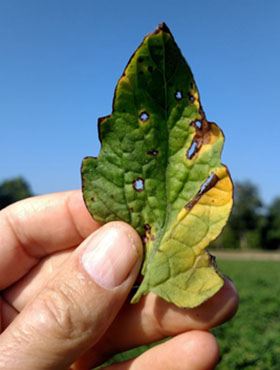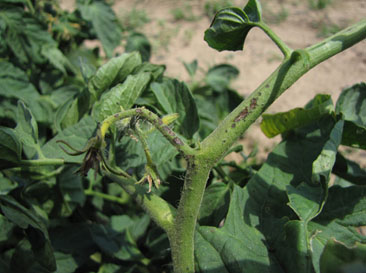Address any questions or comments regarding this newsletter to the individual authors listed after each article or to its editors, Nathan Johanning, 618-939-3434, njohann@illinois.edu or Bronwyn Aly 618-695-6060, baly@illinois.edu. The Illinois Fruit and Vegetable News is available on the web at: http://ipm.illinois.edu/ifvn/. To receive or be removed from email notification of new postings of this newsletter, contact Nathan Johanning or Bronwyn Aly at the phone numbers or email addresses above.
In This Issue:
Upcoming Programs (listings for beginning and established growers)
News and Announcements (Farm to St. Louis Grower Survey)
Regional Reports (west central, southern Illinois, Dixon Springs)
Fruit and Vegetable Production and Pest Management (Pumpkin Disease Management, Tips on Harvesting Bell Peppers, Cut Flower Production in High Tunnels, Managing Bacterial Spot in Tomatoes, Produce Safety: On-Farm Readiness Reviews (OFRR) For Illinois)
Upcoming Programs
Check the Illinois SARE calendar for a full list of programs and links for registration.
http://illinoissare.org/ and http://illinoissare.org/calendar.php
Also see the University of Illinois Extension Local Food Systems and Small Farms Team's website at:
http://web.extension.illinois.edu/smallfarm/ and the calendar of events at http://web.extension.illinois.edu/units/calendar.cfm?UnitID=629.
- Produce Safety Alliance Grower Training Course, Monday, August 13, 2018 8 a.m. – 5 p.m. Jefferson County Extension Office, 4618 Broadway, Mt. Vernon, IL. For more information on this grower training and to register visit http://go.illinois.edu/PSAMtVernon2018 or contact Laurie George at ljgeorge@illinois.edu or 618-242-0780. Registration will close on July 27, 2018. There are a limited number of seats available for this training. Once the course is full, registrations will close.
- Southern Illinois Summer Twilight Series: Blake Gerard Farms, 26845 Ditch Rd., McClure, IL, Monday, August 20, 2018 6 p.m. 6 p.m. This fourth and final twilight meeting of the summer series will cover be at the first rice farm in Illinois and cover production and developing local wholesale and retail marketing and branding of specialty rice. For further information contact Bronwyn Aly at baly@illinois.edu or 618-695-6060.
- 2018 Pumpkin Field Day, Thursday, September 6, 2018, 10 a.m. Ewing Demonstration Center (located about 20 minutes south of Mt. Vernon, IL) 16132 N. Ewing Rd. Ewing, IL 62836. Pumpkin Variety & Pest Management trials, No-till Production and more! This program is FREE and includes lunch but please register at https://web.extension.illinois.edu/registration/?RegistrationID=14998 or by calling the Jackson County office at 618-687-1727, by Monday, September 3, 2018. For additional information contact Nathan Johanning at 618-687-1727 or njohann@illinois.edu.
- Midwest Mechanical Weed Control Field Day Wednesday September 26, 2018 PrariErth farm in Atlanta, Illinois. Visit https://thelandconnection.org/farmers/mechanical-weed-control-field-day-2018 for more details and information about the field day as time gets closer.
News and Announcements
Farm to St. Louis Survey
Missouri Coalition for the Environment (MCE), as part of our work convening the St. Louis Food Policy Coalition, is looking to help farmers within 150 miles of St. Louis reach new markets and grow their business. We see a need for an improved delivery and distribution system that will help farmers maximize production, connect more buyers to local food, and provide a supply chain for value-added production. We also see a need for a regional brand that will promote farmers within our region that use environmentally responsible practices on their farm. This brand will be an opportunity to build a network of farmers in our region, to provide transparency to the consumer about why local is important, and for residents to take pride in being a part of the local food movement. Since these projects are designed to support farmers in our region, we hope that you will complete this questionnaire and provide your feedback.
This questionnaire just takes around 10 minutes to complete!
The goals of this questionnaire are to:
- Share with you and receive feedback on your interest in a regional brand that would promote environmentally responsible farmers,
- Get your feedback on a project idea to make delivery and distribution to St. Louis markets easier and more affordable for farmers so you can maximize production on your farm, and
- Update the Slow Food St. Louis Food Loop Directory (www.slowfoodstl.org/projects/st-louisfood-Loop) and the Missouri Coalition for the Environment Foodshed map online (https://www.moenvironment.org/foodshedmap ).
Visit https://moenvironment.org/17-food-and-farm/487-farmer-questionnaire to complete the survey
If you have any questions, feel free to email MCE's Local Food Coordinator, Rae Miller, at rmiller@moenviron.org, or MCE's Food and Farm Director, Melissa Vatterott, at mvatterott@moenviron.org.
Regional Reports
From west central Illinois... The past two weeks, temperatures in Macomb bounced between the high 80s to low 90s. Rains have been incredibly spotty. Yesterday, while traveling back from Peoria to Macomb, I drove through almost constant rain. When I arrived at the McDonough Extension office, there had been no rain. For July in West Central Illinois, many places have received no precipitation.
I went on vacation during the Fourth of July week. It seems all of the pests came out of the woodwork in that time. The Japanese beetles finally targeted our pole beans. In my continued experiment with organic management of this pest, I sprayed the beans with a micronized clay (Surround WP), to see how that deterred feeding. I coated half the beans and left the other half bare. Sure enough, the Japanese beetles shifted a majority of their feeding to clean leaves. The white residue of the clay spray easily washed off the beans. Some fruits with more pubescence or texture may require thorough cleaning with labeled detergents. I had also heard when Surround was applied to peaches and even after washing there was still a white hue to the fruit, reducing the marketability of the harvest. Test clay sprays before deploying them across an entire crop.
Squash vine borer attacked a few squash plants, which wilted overnight. We buried the affected lower stem in compost, hoping the plant will develop new roots to overcome the borer damage. We also treated the lower stems with carbaryl dust.
Scouting this week found squash bug eggs on the underside of a couple of squash leaves. I still haven't seen any squash bug adults, so I'll keep smashing their eggs and hope that gets most of them.
The plush, green imported cabbage worm, showed up in force on the Brussel sprouts. An application of Bacillus thuringiensis var. kurstaki (Btk) eliminated the young caterpillars.
I've spotted two cucumber beetles among the trellised cukes. However, in my scouting I also found many beneficial insects and pollinators feeding and living on the plants, which stayed my hand at directing any insecticide to the cucumbers. I'll keep monitoring the cucurbits for cucumber beetles. Insecticide thresholds for cucumber beetles are one adult cucumber beetle per plant for cucurbit seedlings and five adults per plant for mature plants. Feeding by adult cucumber beetles can spread bacterial wilt disease among cucurbit plants, even when population density is low. (Michigan State University Extension)
I have somewhat neglected my Cascade hops this year. One bine, in particular, has been far ahead of all the others the entire growing season. In June, the cones on this plant were beautiful, and to me seemed to be almost ready to harvest. (Typically, hops harvest is in August in my area.) Returning from my trip, I noticed this particular bine was past due. The cones are now probably too far-gone for harvest.
Our garlic also seemed ahead of the regular harvest window this year. I spoke with a CSA owner, and he remarked how terrible his garlic did this year. The fluctuating warm to cold this winter kept hammering his garlic crop. I am inclined to agree. Our crop of Musik yielded much smaller bulbs than I've experienced in the past. Spanish Roja was a complete crop failure. However, our planting of Northern White garlic performed very well.

In the foreground, pole beans that were not sprayed with Surround, still encounter moderate to heavy feeding damage from Japanese beetles. In the background, beans are coated with Surround. Feeding damage on the treated plants was minimal. (Photo C. Enroth)
Chris Enroth (309-837-3939; cenroth@illinois.edu)
From southern Illinois... We are in the midst of some typical summer weather in southern Illinois. It has been sunny, hot, and humid with very little relieve from that. Wednesday (7/18) a front did go through, pulling back the humidity and temperatures in the upper 80s which felt nice after the last week of very high humidity and low to mid 90s. Most of the area got rain last weekend. Here in Murphysboro we had 0.8", back at the farm in southern Monroe County we received 3.6" over the weekend. This was great for all of our crops as most areas were in need of some rain and some could use some more. Rain is predicted for Friday of this week and hopefully another break from the humidity which has come back.
Out in the orchard Red Haven peaches are in harvest. We are nearing the end of blueberries and in to the mid and later blackberry varieties. Out in the vegetable field we still have some late planting of tomatoes just going in and growers are just getting fall cole crops started. Harvest on all of our vegetable crops is well underway. The end of last week we dug a potato variety trial that I put out at home on the farm within my usual block of potatoes. We had potatoes of various skin and flesh colors some performing better than others, but some nice options especially to add color to a market display. I don't have all of the data organized yet to share yields, but be watching in future issues on the details of the trial results.

Left: 10 Potato Varieties harvested from the on-farm potato variety trial. Right: Transplanted Jack O'Lantern pumpkins 9 days after transplant. Photos: N. Johanning.
All of the pumpkins we transplanted are off to a good start. The picture shows my pumpkin transplants at home 9 days after transplanting and before they had any additional rain after transplant. They are off to a good start and the rain should really have them growing. Having decent soil moisture is what has kept most of our crops in decent shape through this heat. I know in many parts of the state the moisture has not been as plentiful so we are fortunate for that.
Nathan Johanning (618-939-3434; njohann@illinois.edu)
From Dixon Springs Ag Center... As usual cucumber harvest continues now in our 9th week of harvesting. A few of the cucumber plants are starting to show signs of heat stress as they have slight wilting in the afternoons in the high tunnel, but still no significant signs of disease. We have noted that aphids seem to be very attracted to one variety in particular, Picolino. Greens in the hydroponic lettuce table are not performing well due to the temperature of the water in this recirculating system given the long stretch of high temperature we have had even with the shade cloth and cooling fans in the high tunnel. All of the onions, fennel, celery, and potatoes were harvested this past week. Potatoes performed ok in the high tunnel this season despite, being in raised beds and not being hilled, overall yield was less than yields from field grown potatoes. Quality was acceptable with just a few rotten tubers. Cut flowers, basil, parsley, thyme, and dill continue to thrive. See the article later in this issues to read more about some of the cut flowers. Indeterminate tomatoes continue to be pruned and lowered with a steady harvest twice a week. The determinate varieties are starting to ripen with the majority of first clusters to be picked next week. They have a very nice second and third clusters set and the fourth getting started. Two of the most impressive determinate varieties in the high tunnel are Camaro and Red Mountain. They both have many large, nice fruit without an over abundance of foliage, but have enough canopy cover to prevent sunburn. We will be holding workshops two days next week to put up a smaller high tunnel dedicated to youth STEM and entreprenurial programming.
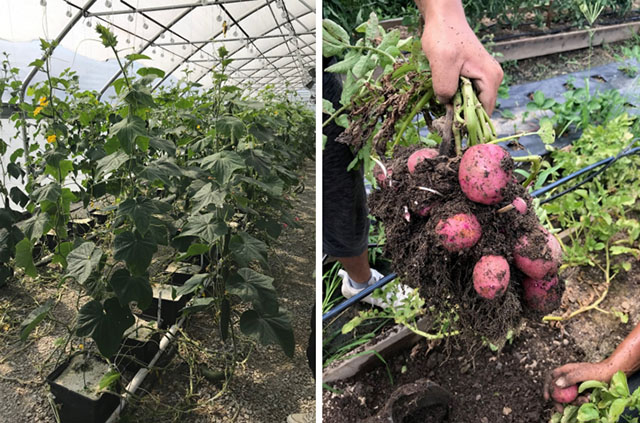
Top Left: Hydroponic Cucumbers in 9th week of harvest. Top Right: High Tunnel Potato harvest. Photos: B. Aly.
Bottom: Camaro (left) and Red Mountain (right) determinate tomatoes from the high tunnel. Photos: J. Zakes.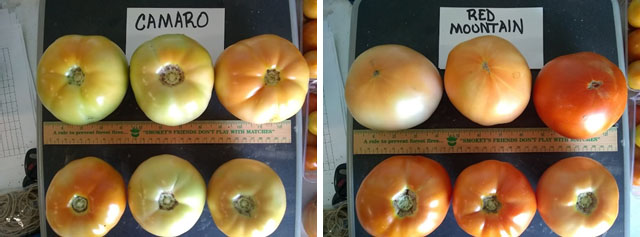
Bronwyn Aly (618-382-2662; baly@illinois.edu)
Fruit and Vegetable Production and Pest Management
Pumpkin Disease Management
As we get into the later part of July, now is the time to start scouting more closely for diseases in pumpkins. Powdery mildew is by far the most prevalent and common pumpkin disease, but also bacterial spot and also in some years downy mildew can also blow into the area. However, I have not heard of any reports yet of downy mildew in any cucurbits in the region as of now
To catch powdery mildew early, we want to be scouting the vines and also undersides of leaves which is where it often shows up first. For best control, start a preventative fungicide program, before or as soon as any infection is noted in the field. Often late July or early August is when we would expect to see infections start.
Please see the link below for the current pumpkin fungicide recommendations from the research our plant pathologist Dr. Mohammad Babadoost.
https://web.extension.illinois.edu/smallfarm/downloads/75931.pdf
For more information or questions about pumpkin disease management contact Dr. Babadoost at 217-333-1523 or babadoos@illinois.edu
Nathan Johanning (618-939-3434; njohann@illinois.edu)
Tips on Harvesting Bell Peppers
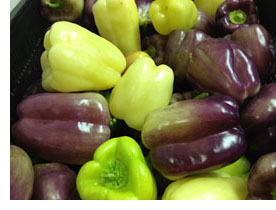 Many of our field-grown peppers are just getting into harvest. For some tips and best practices on pepper harvest visit the Local Food Systems YouTube Channel to see a short video where educator Bronwyn Aly discusses determining when bell peppers are ready to harvest.
Many of our field-grown peppers are just getting into harvest. For some tips and best practices on pepper harvest visit the Local Food Systems YouTube Channel to see a short video where educator Bronwyn Aly discusses determining when bell peppers are ready to harvest.
https://www.youtube.com/watch?v=KzPFJ8QEsAc
Also, remember that we have over 100 recorded Webinars on a variety of production related topics on the YouTube Channels to take a look if there is a crop you are wanting to learn more about.
https://www.youtube.com/channel/UCBvG-jopax3tPSCBXb6AgIQ
Nathan Johanning (618-939-3434; njohann@illinois.edu)
Cut Flower Production in High Tunnels
We have been experimenting with some cut flowers in the high tunnels at the Dixon Springs Ag Center and here are a few notes and thoughts about what we have learned this season so far.
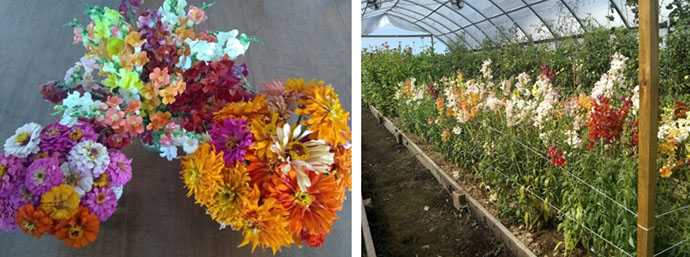
Left: From left to right, Come and Cut Again, Zinnia, both Chantilly Formula Mix and Madame Butterfly, snapdragons, and Giant Cactus, zinnia. Right: Trellis weave used for support of the flowers in the high tunnel at the Dixon Springs Ag Center. Photos: J. Zakes.
We grew both zinnias and snapdragons in ground beds in the high tunnels. All were started in the greenhouse on March 2, 2018 and transplanted into the high tunnel on the second week of May. 'Come and Cut Again' and 'Giant Cactus' zinnias from Livingston Seed on March 2nd and transplanted the second week of May. I had to trellis weave them to prevent them falling over. Pests have included Japanese beetles, army worm, and grasshoppers. Almost all of the pest damage is to the leaves and not the flowers. I'm not sure if they are keeping the pests from the tomatoes and peppers, but those are almost pest free.
The snapdragons are donated from Johnny's Selected Seeds and are 'Chantilly Formula Mix' and 'Madame Butterfly' (middle of picture). They appear to be pest free thus far this season. Both have been easy to care for and yielded well. Note on snapdragons these varieties grow tall and are specifically geared for cut flower use. Many common varieties you find at your local garden center for home garden use and are not tall enough to cut for cut flowers so be specific when choosing varieties. Both snapdragons and zinnias you can get a continuous harvest as new flowers from throughout the season.
For both we did a trellis weave similar to what you would do for peppers to provide support to keep them standing up straight. If the flowers fall over, especially the snapdragons, they will bend up towards the light and that can limit their usefulness in arrangements. In the air conditioning in a vase of water both will last about a week or so.
A special thanks to Johnny's Selected Seeds for their seed donation and support of the Ag Center!
Julie Zakes (zakes@illinois.edu)
Managing Bacterial Spot in Tomatoes
Bacterial spot of tomato has been observed across Indiana this summer. Leaf spots are usually 1/16 inch, and dark. Where lesions are numerous upon a leaf, the tissue may be chlorotic (yellow) (Figure 1 & 2). (In contrast, each lesion of bacterial speck is often accompanied by chlorosis whether lesions are numerous or not.) Lesions of bacterial spot on fruit are dark, raised and up to 1/3 inch in diameter (Figure 3). The disease prefers warm, wet weather. Overhead irrigation will also spread this disease. Although much of Indiana has been dry recently, rainy weather earlier in the year has increased the severity of bacterial spot.
|
|
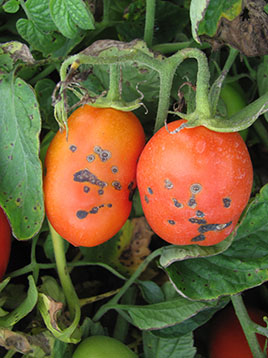
Figure 3. Lesions of bacterial spot
of tomato often appear scabby. Photos: D. Egel
Bacterial spot is much more common in field tomatoes than in greenhouse or high tunnel tomatoes. This is because bacterial spot requires leaf wetness for infection to take place and rain to spread the bacteria from leaf to leaf and from plant to plant. For the most part, tomato plants under cover lack sufficient leaf wetness to allow bacterial spot to become a problem.
You may have heard about bacterial spot of pepper and pumpkin. Bacterial spot of pepper is closely related and may be able to go to tomato. Bacterial spot of pumpkin is related but will not go to pepper or tomato.
Successful management of bacterial spot will take a combination of cultural and pesticide treatments. Since bacterial spot may be seed borne; the disease may have been brought in on your seed/transplants. However, the causal bacterium also survives on crop residue. Tomatoes should be rotated 2 to 3 years away from peppers or tomatoes. Treatment with copper hydroxide may reduce spread in the field. Some strains of the bacterial spot pathogen are resistant to copper products. In a recent Purdue University study in 2016 and 2017, 84% of bacterial spot strains collected were copper insensitive (resistant). To increase the amount of copper available on the leaf, copper products may be mixed with fungicides with the active ingredient mancozeb (e.g., Dithane®, Manzate®, Penncozeb®). Many copper products may be used in some organic schemes.
Streptomycin products are labeled for use on tomatoes only in the transplant greenhouse (e.g., Agri-mycin®, Harbour®). The survey mentioned above found that 58% of bacterial spot strains were insensitive to streptomycin. So, it makes sense to treat with a streptomycin in the transplant greenhouse before going to the field.
Products with the active ingredient hydrogen dioxide (e.g., Oxidate®) are also labeled for bacterial spot in the field and greenhouse. Hydrogen dioxide can kill bacteria on contact, however, it has very little to no residual. In general, I do not recommend the application of hydrogen dioxide products in the field for control of bacterial spot. The use of Oxidate® in the greenhouse makes more sense since the product can be easily applied multiple times. Do not substitute hydrogen dioxide for copper, streptomycin or Actigard®. Be careful when mixing Oxidate® with other products. When used with copper products, for example, Oxidate® may not mix well. Read the labels of all the products carefully. Oxidate® may be used in some organic schemes.
Another product that has been used for management of bacterial spot of tomato is acibenzolar-S-methyl (trade name Actigard®). Acibenzolar (ASM) does not have any activity against bacteria or fungi. ASM is known as a systemic acquired resistance product. That is, it 'tells' the plant to turn on biochemical pathways that defend the plant from infection. ASM has been used with copper products to lessen the severity of bacterial spot of tomato. However, ASM can cause yield loss if used on tomatoes that are stressed due to drought or other environmental factors.
Serenade Opti® (an older name for this product is Serenade Max®) is labeled against bacterial spot of tomato. The action of Serenade Opti® is reported to be due to a protein component of the bacterial ingredient and to a systemic acquired resistance activity similar to that described for ASM. In a Purdue University study last year, where Serenade Opti® was applied every two weeks, Serenade Opti® did not significantly lower bacterial spot compared to the untreated control. Other researchers have had better results. Serenade Opti® may be used in some organic schemes.
A similar microbial product is called LifeGard® (the active ingredient of LifeGard® is a different, but related bacterium). The mode of action is similar to Actigard® and to Serenade Opti®-the product is reported to activate plant host defenses. Since this product is very new, I know very little about it. However, I am trialing this product this summer.
Another product that will not be influenced by whether the pathogen is copper resistant or not is AgriPhage®. This product is a microbe that parasitizes and ultimately kills the pathogens described here. AgriPhage® is very specific in which strain of pathogen is attacked. One must work closely with the manufacturer, Omnilytics®, to obtain product that will be most likely to work in one's region. In a two-year study (the same Purdue University study referenced above) AgriPhage® was used in processing tomato trials in commercial fields. I was not able to show that AgriPhage® was any better than the commercial standard of copper, mancozeb and Actigard®. But AgriPhage® was no worse. The best treatment seemed to be 3 or 4 applications of AgriPahge® after first flower. Then the growers returned to the commercial standard. AgriPhage® should not be tank mixed or contaminated with copper products. Similarly, Oxidate® will react adversely with AgriPhage®. AgriPhage® is recognized by the National Organic Program (NOP) but not by the Organic Materials Review institute (OMRI).
The fungicide Tanos® (common name of active ingredients, famoxadone, cymoxanil) has been trialed for activity against bacterial spot of tomato. While the results have not always been positive, it might make sense to use Tanos® when one is trying to manage one of the fungal diseases on the Tanos® label (for example anthracnose, early blight, late blight, Septoria leaf blight) and hope for some activity against bacterial spot as well.
Organic growers should always carefully consult with their certifying agency about what is allowed in their certification program.
Dan Egel, Extension Plant Pathologist, Purdue Vegetable Crops Hotline, Purdue University (812-886-0198; egel@purdue.edu)
Produce Safety: On-Farm Readiness Reviews (OFRR) For Illinois
The On-Farm Readiness Review (OFRR) is a voluntary, non-regulatory educational opportunity for Illinois farmers, subject to the Food Safety Modernization Act (FSMA) Produce Safety Rule. This program will assist growers to be better prepared for regulatory inspections on their farms. The program in Illinois is being offered, free of charge, to any farmer that has completed a Produce Safety Alliance Grower Training workshop (or equivalent).
In Illinois, the Food and Drug Administration will be responsible for farm inspections under the FSMA Produce Rule. To understand what this means, you need to become familiar with the differences between a third-party audit and a FDA inspection:
Third-Party Audit:
- Audits are usually points based, meaning the farm either passes/fails depending on the number of points received during the farm inspection by the third-party auditor
- Audits are done annually
- Audits are crop specific
- The consequences of failure to pass an audit are potential loss of sales
FDA Inspections:
- Are not point-based
- Inspections are intermittent, meaning FDA may request an inspection once every 3-5 years, based on the safety record of the farm
- An inspection covers the whole farm, not just specific crop(s)
- Regulatory consequences of non-compliance with the Produce Safety Rule can result in additional visits by the FDA, or shutting down of farm operations
While some farms may be familiar with the Produce Safety Rule and how it impacts their farm, others may be less familiar. The On-Farm Readiness Review provides an opportunity for farmers, at any level of preparedness, to get individual feedback on their readiness for compliance with the Produce Safety Rule before they receive their first inspection. This tool is consistent with FDA's "Educate Before and While We Regulate" approach. On-farm reviews will cover farm practices that may include growing, harvesting, and postharvest activities on the farm. FDA farm inspections will begin in 2019.
Farmers who have interest in having an OFRR of their farm should contact the Food and Drug Administration at RequestAnOFRR@fda.hhs,gov or by mail:
U.S. Food and Drug Administration
c/o Produce Safety Network
5001 Campus Drive
College Park, MD 20740
Additional information concerning the Produce Safety Rule and OFRR can be found at:
https://www.farmcrediteast.com/knowledge-exchange/Blog/todays-harvest/fsma-update---wall
Laurie George (618-548-1446; ljgeorge@illinois.edu)
Less Seriously ...
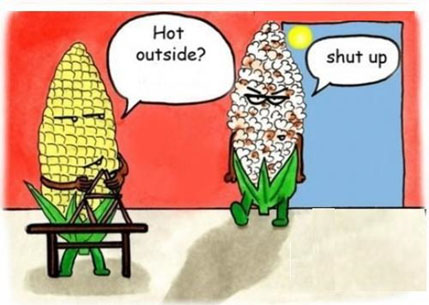
http://www.bestfunnyjokes4u.com/wp-content/uploads/2012/12/great-funny-cartoon.jpg
University of Illinois Extension Specialists in Fruit and Vegetable Production & Pest Management
Extension Educators – Local Food Systems and Small Farms |
||
Bronwyn Aly, Gallatin, Hamilton, Hardin, Pope, Saline, and White counties |
618-382-2662 |
|
Katie Bell, Franklin, Jackson, Perry, Randolph, & Williamson counties |
618-687-1727 |
|
Sarah Farley, Lake & McHenry counties |
847-223-8627 |
|
Nick Frillman, Woodford, Livingston, & McLean counties |
309-663-8306 |
|
Laurie George, Bond, Clinton, Jefferson, Marion, & Washington counties |
618-548-1446 |
|
Zachary Grant, Cook County | 708-679-6889 | |
Doug Gucker, DeWitt, Macon, and Piatt counties |
217-877-6042 |
|
Erin Harper, Champaign, Ford, Iroquois, and Vermillion counties |
217-333-7672 |
|
Grace Margherio, Jackie Joyner-Kersee Center, St. Clair County |
217-244-3547 |
|
Grant McCarty, Jo Daviess, Stephenson, and Winnebago counties |
815-235-4125 |
|
Katie Parker, Adams, Brown, Hancock, Pike and Schuyler counties |
217-223-8380 |
|
Kathryn Pereira, Cook County |
773-233-2900 |
|
James Theuri, Grundy, Kankakee, and Will counties |
815-933-8337 |
|
Extension Educators – Horticulture |
||
Chris Enroth, Henderson, Knox, McDonough, and Warren counties |
309-837-3939 |
|
Richard Hentschel, DuPage, Kane, and Kendall counties |
630-584-6166 |
|
Andrew Holsinger, Christian, Jersey, Macoupin, & Montgomery counties |
217-532-3941 |
|
Extension Educators - Commercial Agriculture |
||
Elizabeth Wahle, Fruit & Vegetable Production |
618-344-4230 |
|
Nathan Johanning, Madison, Monroe & St. Clair counties |
618-939-3434 |
|
Campus-based Extension Specialists |
||
Kacie Athey, Entomology |
217-244-9916 |
|
Mohammad Babadoost, Plant Pathology |
217-333-1523 |
|
